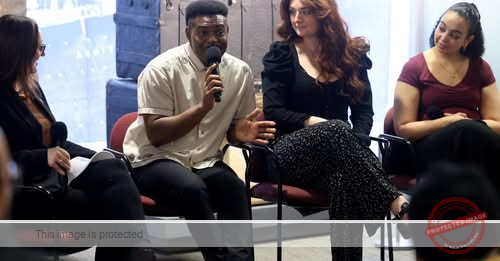
With the national tour of “Hadestown” currently back in Chicago for a two-week run, theater presenter Broadway in Chicago partnered with the National Hellenic Museum to host a panel discussion on Thursday about the Greek mythology behind the Tony Award-winning musical. Moderated by museum publicist Elizabeth Niarchos Neukirch, the event featured three cast members from the touring production in conversation with Krishni Burns, a classics and senior Mediterranean studies lecturer at the University of Illinois Chicago.
Located in Chicago’s Greektown neighborhood, the National Hellenic Museum has a mission to share Greek history, art, culture and the Greek American story. Greek mythology is at the heart of “Hadestown,” Anaïs Mitchell’s folk-inspired reimagining of two classic tales: the ill-fated journey of young dreamer Orpheus to the Underworld to rescue his beloved Eurydice, and the complicated romance between Hades and Persephone, which has turbulent effects on the natural world.
As Burns noted, these myths have been around for about 3,000 years and have continued to “accrue meaning” through countless retellings. “We keep on telling these stories because they remain relevant,” she said. “They help us explore ideas, express emotions and really delve into a depth of experience that we otherwise have a hard time accessing until we’re in the midst of it and don’t know how to deal with it. So, this is a place to grow as human beings through these stories.”
Although the tale of Orpheus and Eurydice is famously tragic, “Hadestown” tells it with a sense of bittersweet hope. Near the end of the show, Hermes — the messenger god who acts as narrator — sings, “It’s a sad song / But we sing it anyway.” In spoken verse, Hermes adds, “’Cause here’s the thing: To know how it ends / And still begin to sing it again / As if it might turn out this time.”
Jaylon C. Crump, who plays Hermes in the touring cast, finds a lot of meaning in this outlook. “I think that it is just like a ‘life imitates art’ moment with me, personally, about how I view the world,” they said. “I feel like I wake up with (renewed) hope every single day, and I think that the show has really taught me that.”
Crump also believes that audiences resonate with this message. “With how the world is right now, the story of Orpheus and Eurydice and Hades and Persephone is so much more relevant now than it’s ever been. And I think that a lot of people leave the show with a newfound resilience and hope that they may have lost or may be trying to find again.”
As a swing who covers eight of the show’s 13 roles, Julia Schick experiences the story of “Hadestown” from a different perspective nearly every time she performs. “I think for me, the core of the show is about love and the different ways that people show their love and the lengths that you will go to for love — not just love for others, but love for your work and love for yourself,” said Schick. “And as someone who is pursuing my passion, while it can be difficult traveling all over the country, it is not something I want to give up. I get to wake up every day and do what I love, and the lengths I would go for this love are astronomical.”
Katelyn Crall plays one of the Fates, the three female figures from Greek mythology who represent the role of destiny in the individual lives of mortals. In her view, the fallibility of the show’s characters makes the story feel true-to-life. “I don’t think there really is a good guy in ‘Hadestown.’ Every one of the characters has intrinsic faults and makes almost fatal mistakes,” she said.
“Why do we still root for them? It’s a very, very interesting thing,” Crall continued. “It also plays (on) the fact that all humans are intrinsically flawed and we’re always fighting our own demons, and to mistake, to err, is human. And I think that’s what makes ‘Hadestown’ so relatable, and that’s why we keep on getting drawn to it, because everyone sees themselves in these characters even though they make really bad choices a lot of the time.”
The humanity of these characters, even those who are technically gods, also comes through in the personalized way that actors approach their roles. “The good thing about ‘Hadestown’ is that they really want you to bring yourself to the character,” said Crump, who is the youngest and first nonbinary actor to play Hermes. Their version of Hermes is “completely genderless,” which is communicated through minor changes in the text, and has more of a peer-to-peer than parental relationship with Orpheus since they are similar ages.
As a self-described “dark-skinned Black queer person,” Crump also spoke to the importance of representation and bringing their authentic self to the stage. “I’m giving the audience a piece of myself, and sometimes that audience doesn’t want it — we’re in different states, different political climates — but I’m giving it to you, and whether you receive it or not is on you.”
Crump added that they have received a warm reception “from so many people, especially members of the LGBTQ community. I’ve gotten so many messages from teenagers, from kids, from adults, from so many people of color, who have told me, ‘I’m so glad that I was able to see somebody that looked like me on stage, and it’s so inspiring.’”
The current touring cast recently gave its 200th performance, but Crall, Crump and Schick show no signs of waning enthusiasm for this story. The tour will go on hiatus after the Chicago run, but “Hadestown” will return to cities across the U.S. this fall. To echo Hermes, it’s an old tale from way back when, and they’re gonna sing it again and again.
Emily McClanathan is a freelance critic.
